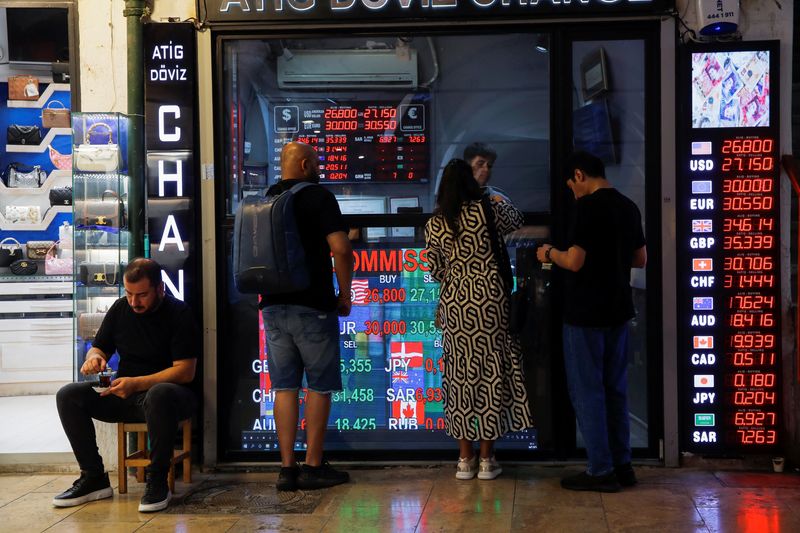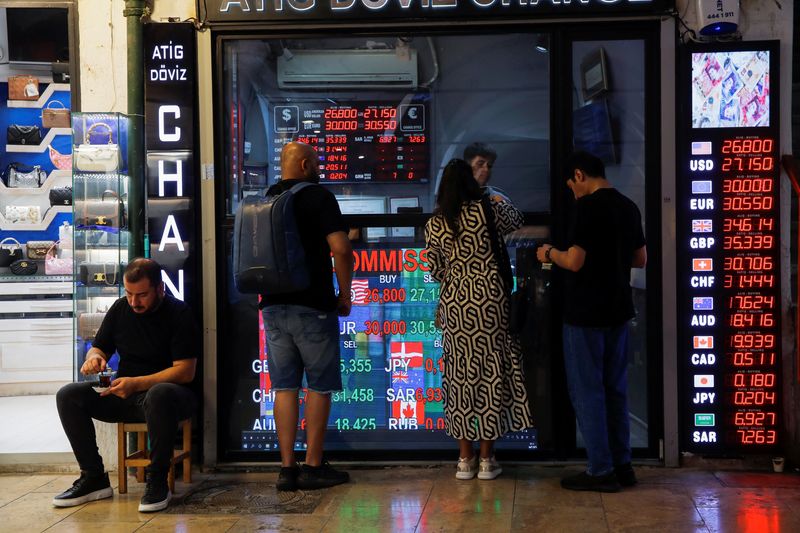Forex
Dollar mixed in tight trading range before Fed statement


© Reuters. People visit a currency exchange office in Istanbul, Turkey July 18, 2023. REUTERS/Dilara Senkaya/File Photo
By Karen Brettell
NEW YORK (Reuters) -The dollar edged lower against the euro and higher against the yen on Tuesday, but failed to find strong direction ahead of the conclusion of the Federal Reserve’s two-day meeting.
The U.S. central bank is expected to leave interest rates unchanged on Wednesday and investors will focus on any clues from Fed Chairman Jerome Powell on the likelihood of a rate cut in March.
Solid U.S. economic data has led traders to pare bets of a March cut to a 42% probability, from around 89% a month ago, according to the CME Group’s (NASDAQ:) FedWatch Tool.
The Fed may “feel more confident than they were in December that rates are restrictive enough to bring inflation down,” said Marc Chandler, chief market strategist at Bannockburn Global Forex in New York.
But the Fed also could indicate that it is “not in as much of a hurry as the market expects to cut rates,” Chandler added. The central bank could also suggest that it does not want rates to be too restrictive as it aims to generate a soft economic landing, Chandler noted.
Many analysts expect the Fed’s first rate cut will be aimed at preventing too wide a gap between inflation and the fed funds rate, as this would tighten financial conditions more than the Fed intends.
Treasury yields fell and the dollar weakened after Powell in December indicated that the Fed was pivoting to an easing cycle.
The was last down 0.07% at 103.39. The currency is largely seen as consolidating before Wednesday’s Fed decision and highly anticipated U.S. jobs data for January due on Friday.
Data on Tuesday showed that U.S. job openings unexpectedly rose in December while U.S. consumer confidence increased to a two-year high in January.
Friday’s data is expected to show that employers added 180,000 jobs in January.
The euro gained after data showed the euro zone avoided a technical recession in the fourth quarter. It was last up 0.13% at $1.08460.
Gross domestic product (GDP) in the 20 countries sharing the euro was flat in the fourth quarter against the previous three months, mainly because of strong growth in Portugal and Spain and a modest increase in Italy, while the German economy shrank in the final three months of 2023.
The dollar has rebounded against the single currency this year on expectations that the U.S. economy will fare better than the euro zone.
Investors are fully pricing in a rate cut by the European Central Bank in April.
“For the ECB, (Tuesday’s) figure eases the pressure somewhat, but it is clear that the so-called soft landing being pursued by (ECB President Christine) Lagarde has been somewhat softer than many would have liked,” said Joshua Mahony, chief market analyst at Scope Markets.
Sterling slid 0.11% to $1.26925 ahead of the Bank of England’s monetary policy meeting this week.
The U.S. currency rose 0.09% to 147.62 against the yen.
Japan’s jobless rate fell to 2.4% in December from the previous month, government data showed on Tuesday, just under economists’ median forecast of 2.5% in a Reuters poll.
In cryptocurrencies, bitcoin rose 0.91% to $43,555.

 Forex3 years ago
Forex3 years agoForex Today: the dollar is gaining strength amid gloomy sentiment at the start of the Fed’s week

 Forex3 years ago
Forex3 years agoUnbiased review of Pocket Option broker

 Forex3 years ago
Forex3 years agoDollar to pound sterling exchange rate today: Pound plummeted to its lowest since 1985

 Forex3 years ago
Forex3 years agoHow is the Australian dollar doing today?

 Cryptocurrency3 years ago
Cryptocurrency3 years agoWhat happened in the crypto market – current events today

 World3 years ago
World3 years agoWhy are modern video games an art form?

 Commodities3 years ago
Commodities3 years agoCopper continues to fall in price on expectations of lower demand in China

 Economy3 years ago
Economy3 years agoCrude oil tankers double in price due to EU anti-Russian sanctions























